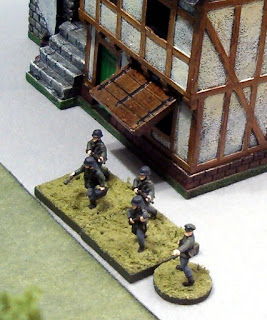This weekend's hobby time was devoted mostly to some terrain matters. First off, I cut down to size the large piece of felt I had found to cover my entire 6' x 4' table.
I say, "cut down" because I intentionally purchased a piece that was about double the size of my table, so that I could use the excess to make tree skirts.
I'd been bothered for a while about how the color of my tree bases don't quite match my felt. Then it occurred to me that I could use excess felt of the same color to make tree skirts (like with a Christmas tree).
Like any other terrain base, if the model is on the tree skirt, it's considered to be in the cover of the trees.
While I was at it, I took the time to cut some gray felt to make roads and paved areas for buildings. Just as with the tree skirts, the paved areas will act as an abstract way to show that a unit is in the building.
Finally, just because I was in the mood, I put together and painted a Sherman tank by Armourfast.
Sunday, October 9, 2011
Subscribe to:
Post Comments (Atom)
Two Up, One Back
"The dominant (though not the only) tactical formation for the infantry in both attack and defense remained 'two up, one back.' This was a product of the triangular organization that the infantry used from platoon to division level. Triangular units had three main 'maneuver' elements (weapons units did not count as 'maneuver' elements). Rifle platoons had three squads; rifle companies three rifle platoons; battalions, three rifle companies; and so forth. This encouraged commanders to place two of their maneuver units forward while keeping back the third so that it could relieve or reinforce a frontline unit."
--John Sayen, U.S. Army Infantry Divisions 1944-45 (28)






Tree skirts...now that's a good idea!
ReplyDeleteThanks for sharing it. I might try it with some of my non-WWII troops & trees.
Thats a great idea for the trees. Your table looks excellent!
ReplyDeleteThat's a great idea.
ReplyDeleteGood work and a great idea.
ReplyDeleteAgreed nice idea, good work on the Sherman as well.
ReplyDeleteThanks guys -- glad you like the idea. I've pillaged so many cool ideas off other peoples' websites, it's about time I start trying to give a little something back, however small. :)
ReplyDeleteGreat work! and it really works. Nice one Bard!!
ReplyDeleteAwesome looking table, splendid attention to detail
ReplyDelete